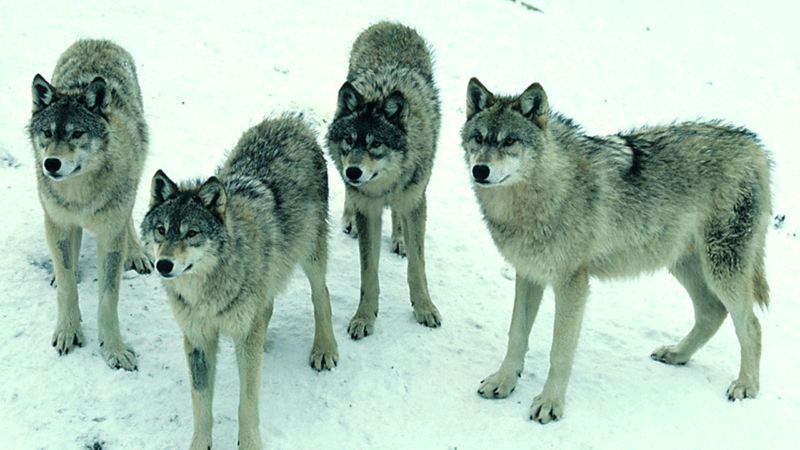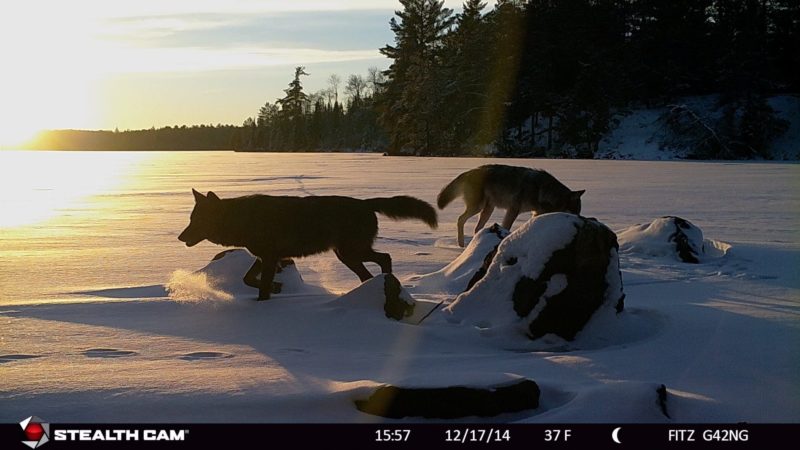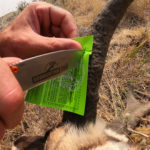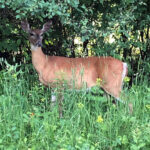Since 1995, when they were first reintroduced in Yellowstone National Park, wolves have been a topic of controversy among sportsmen as well as the non-hunting public. The gray wolf is an apex predator that primarily feeds on deer, elk, moose, and other ungulates, and they can positively influence the balance of these prey species with their habitat. Recently, some scientists have speculated using wolves to help control the spread of Chronic Wasting Disease (CWD), but is that realistic?

“No,” says Kip Adams, who has almost 20 years of experience working with CWD and is currently the Chief Conservation Officer for the National Deer Alliance. “Wolves are great predators where they live. They certainly can take out the weaker and sicker animals. So in those areas, they may help limit the spread of CWD a little bit, but that is not going to solve our CWD problems. Even in areas where wolves live, hunters and state agencies are the only ones that will be able to do that.”
As Adams explains, the main reason comes down to simple logistics. “The best way to combat the disease is to strategically remove CWD-positive animals from the landscape, and hunters and state agencies can do that best with targeted removal. We obviously can’t move wolf packs around from one area to another based on where we have outbreaks. I’m not saying that wolves can’t contribute to limiting the spread of CWD where they live, but I’ve also read the stuff where people look at them as the savior, and that’s simply not true.”
How CWD Works
CWD was first found in research mule deer herds in Colorado in 1967. By the late 1970s, captive herds of mule deer, black-tailed deer, and elk in Colorado and Wyoming began exhibiting signs of the disease, which include drooling, staggering, emaciation, and eventual death. The first case of CWD in a wild animal, an elk, was documented in 1981, and later found in mule deer in Wyoming and Colorado by 1985. CWD first appeared in wild whitetail deer in South Dakota in 2001.
Since then, the disease has spread through captive and wild herds throughout North America, including 26 states, several Canadian provinces, South Korea, and Scandinavia. But as Adams points out, most of those CWD cases are isolated within portions of each state rather than the entire state. “It’s not everywhere yet,” he says. “If we look at where it exists, most of the counties within the whitetail’s range do not have CWD.”
The disease is caused by an abnormal version of a cell protein called a prion. These prions can remain in the soil and vegetation for 10 years or more, which means that even if a population dies out or is culled, new animals that move in can also become infected with the disease.
Further complicating the spread of CWD is the extremely social nature of whitetails.
“They basically live in social groups with a bunch of related individuals,” says Adams. “Grandmothers and mothers and aunts and sisters are all there together. Some research out of Wisconsin shows that when an adult doe is CWD positive, all of her relatives nearby are 10 times more likely to contract the disease. So while the bucks can carry the disease into new areas during fall dispersal and during the rut, these doe groups end up being reservoirs for the disease that we can never eradicate from the environment.”

The Role of Predators
Scientists are unclear of the origins of CWD, but some believe its spread is a result of too few apex predators and scavengers. They argue that if populations of these predators and scavengers were restored throughout their historical ranges, our CWD problems would be curtailed.
Of course, fake “conservation” groups such TWIN: Timber Wolf Information Network and the National Wolfwatcher Coalition are quick to jump onboard, many citing that hunters only resist the idea because we view wolves as competition.
In reality, even where they thrive, wolves are not responsible for any reduction in tag allocations for deer hunters. The one exception could be Alaska where unchecked wolf populations decimated moose and caribou populations in some areas where native peoples depended on the meat from those animals for winter survival. In that instance, wolves were culled to bring their population in balance with the environment.
There’s no scientific data to back up the claims that wolves are effective at stopping the spread of CWD. Most of the evidence available is circumstantial at best. Just because we have wolves in Yellowstone National Park and no current cases of CWD in that same park does not mean wolves have stopped the spread. In fact, in 2018 a hunter-killed deer in Dickinson County in Michigan’s Upper Peninsula tested positive for CWD, and that region has had a strong wolf population for decades.
Another thing to consider is the resilience of CWD. A 2015 study found that CWD prions remained infectious even after passing through a coyote’s digestive system. That study also references another study that found that CWD prions remained infectious after passing through crows, too. What makes scientists believe these prions wouldn’t also be transmitted through wolf feces?
We often hear that wolves prey on the weak and sick. Logic might suggest that animals with CWD would fall into this category and be the first to be culled by predators, but consider this: deer with CWD can remain asymptomatic for 1.5-2.5 years before showing signs of the disease. During that time, how many other deer could that CWD-positive deer infect?
“Once they start showing signs of CWD, deer deteriorate pretty rapidly,” says Adams. “But the vast majority of the deer that have CWD are asymptomatic and end up dying from other causes. Something else kills them first, whether it’s a car, bullet, or whatever.”
It’s easy to believe that these deer will die anyway, so what’s the big deal over CWD. As Adams points out, though, research shows that any deer today that has CWD is 2-3 times more likely to die this year than a healthy deer. Even though they may not show any symptoms, they’re not as good at avoiding predators, such as wolves and hunters, or even as good at getting a balanced diet.
The Role of Hunters
The argument for the return of apex predators to their historical ranges has been an ongoing conversation (and debate) for years. Many people believe that the environment would fare much better without human interference and instead relied on the predator-prey relationships that existed prior to the arrival of settlers on this continent. However, long before settlers came here, Native Americans played a huge role in wildlife management.
“If you look at the history books,” says Adams, “back 1500 years ago in what are now the United States and Canada, Native Americans were killing about 7-8 million deer per year. Do you know how many deer are killed by hunters today in the United Sates? About 6 million.”
He continues, “The reality of it is that for at least the last 2000 years, humans have been the dominant predator of deer. Not wolves. Not bears. Not mountain lions. And when you think about 1500 years ago, when we had a lot more apex predators on this continent, humans were still by far the dominant predator. So the notion that we could get back to some natural state if we just had more apex predators is simply not true.”
Adams is also clear that he thinks wolves have their place and can be effective at limiting the spread of CWD where they already live. Ultimately, though, hunters will be responsible for combatting the disease nationwide. “I’m an optimist,” says Adams. “We’ve solved some pretty big issues in the past about deer, and I think we will solve this.”
“Right now, we need to focus on limiting the spread of it by not moving live deer and not moving the high-risk parts of deer that we shoot during hunting season so that we can give science time to catch up. We have quicker tests. We learn more about CWD every day and the potential to decontaminate environments. If we can just keep the disease contained, I’m very confident that we will solve this.”
The truth is that most pro-wolf groups are also anti-hunting groups. Their ultimate goal is to get more wolves on the landscape in order to limit hunting opportunities, and they’re trying to use CWD to advance that goal. Despite this agenda, science and history prove that hunters are, and always have been, the best line of defense against the spread of CWD.

 By
By 



